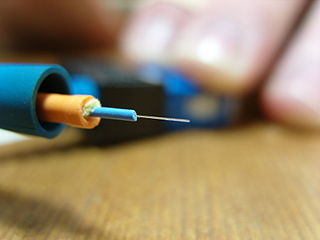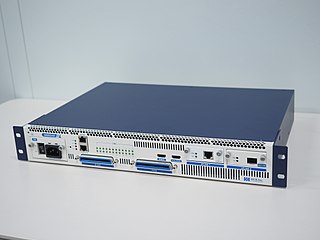Related Research Articles

The ITU Telecommunication Standardization Sector (ITU-T) is one of the three sectors of the International Telecommunication Union (ITU). It is responsible for coordinating standards for telecommunications and Information Communication Technology such as X.509 for cybersecurity, Y.3172 and Y.3173 for machine learning, and H.264/MPEG-4 AVC for video compression, between its Member States, Private Sector Members, and Academia Members.
A graded-index or gradient-index fiber is an optical fiber whose core has a refractive index that decreases with increasing radial distance from the optical axis of the fiber.

In fiber-optic communication, a single-mode optical fiber (SMF), also known as fundamental- or mono-mode, is an optical fiber designed to carry only a single mode of light - the transverse mode. Modes are the possible solutions of the Helmholtz equation for waves, which is obtained by combining Maxwell's equations and the boundary conditions. These modes define the way the wave travels through space, i.e. how the wave is distributed in space. Waves can have the same mode but have different frequencies. This is the case in single-mode fibers, where we can have waves with different frequencies, but of the same mode, which means that they are distributed in space in the same way, and that gives us a single ray of light. Although the ray travels parallel to the length of the fiber, it is often called transverse mode since its electromagnetic oscillations occur perpendicular (transverse) to the length of the fiber. The 2009 Nobel Prize in Physics was awarded to Charles K. Kao for his theoretical work on the single-mode optical fiber. The standards G.652 and G.657 define the most widely used forms of single-mode optical fiber.
All-silica fiber, or silica-silica fiber, is an optical fiber whose core and cladding are made of silica glass. The refractive index of the core glass is higher than that of the cladding. These fibers are typically step-index fibers. The cladding of an all-silica fiber should not be confused with the polymer overcoat of the fiber.

Small Form-factor Pluggable (SFP) is a compact, hot-pluggable network interface module format used for both telecommunication and data communications applications. An SFP interface on networking hardware is a modular slot for a media-specific transceiver, such as for a fiber-optic cable or a copper cable. The advantage of using SFPs compared to fixed interfaces is that individual ports can be equipped with different types of transceiver as required.
A passive optical network (PON) is a fiber-optic telecommunications technology for delivering broadband network access to end-customers. Its architecture implements a point-to-multipoint topology in which a single optical fiber serves multiple endpoints by using unpowered (passive) fiber optic splitters to divide the fiber bandwidth among the endpoints. Passive optical networks are often referred to as the last mile between an Internet service provider (ISP) and its customers.
Dispersion-shifted fiber (DSF) is a type of optical fiber made to optimize both low dispersion and low attenuation.
Non-zero dispersion-shifted fiber (NZDSF), specified in ITU-T G.655, is a type of single-mode optical fiber which was designed to overcome the problems of dispersion-shifted fiber. NZDSF is available in two primary flavours: NZD+ and NZD-, which differ in their zero-dispersion wavelengths. These are typically around 1510 nm and 1580 nm, respectively. Because the zero-dispersion point of NZDSF is outside of the normal communications window, four-wave mixing and other non-linear effects are minimized. Other types of NZDSF include RS-NZDSF which has a reduced slope in its change of dispersion and large core NZDSF which further reduces residual non-linear distortion under high launch power.

Multi-mode optical fiber is a type of optical fiber mostly used for communication over short distances, such as within a building or on a campus. Multi-mode links can be used for data rates up to 100 Gbit/s. Multi-mode fiber has a fairly large core diameter that enables multiple light modes to be propagated and limits the maximum length of a transmission link because of modal dispersion. The standard G.651.1 defines the most widely used forms of multi-mode optical fiber.

Fiber-optic communication is a method of transmitting information from one place to another by sending pulses of infrared light through an optical fiber. The light is a form of carrier wave that is modulated to carry information. Fiber is preferred over electrical cabling when high bandwidth, long distance, or immunity to electromagnetic interference is required. This type of communication can transmit voice, video, and telemetry through local area networks or across long distances.
G.984, commonly known as GPON, is a standard for passive optical networks (PON) published by the ITU-T. It is commonly used to implement the outermost link to the customer of fibre-to-the-premises (FTTP) services.
Networking cables are networking hardware used to connect one network device to other network devices or to connect two or more computers to share devices such as printers or scanners. Different types of network cables, such as coaxial cable, optical fiber cable, and twisted pair cables, are used depending on the network's topology, protocol, and size. The devices can be separated by a few meters or nearly unlimited distances.
10G-PON is a 2010 computer networking standard for data links, capable of delivering shared Internet access rates up to 10 Gbit/s over existing dark fiber. This is the ITU-T's next generation standard following on from GPON or Gigabit-capable PON. Optical fibre is shared by many subscribers in a network known as FTTx in a way that centralises most of the telecommunications equipment, often displacing copper phone lines that connect premises to the phone exchange. Passive optical network (PON) architecture has become a cost-effective way to meet performance demands in access networks, and sometimes also in large optical local networks for "Fibre-to-the-desk".

Telecommunication is the transmission of information by various types of technologies over wire, radio, optical, or other electromagnetic systems. It has its origin in the desire of humans for communication over a distance greater than that feasible with the human voice, but with a similar scale of expediency; thus, slow systems are excluded from the field.

G.fast is a digital subscriber line (DSL) protocol standard for local loops shorter than 500 meters, with performance targets between 100 Mbit/s and 1 Gbit/s, depending on loop length. High speeds are only achieved over very short loops. Although G.fast was initially designed for loops shorter than 250 meters, Sckipio in early 2015 demonstrated G.fast delivering speeds over 100 Mbit/s at nearly 500 meters and the EU announced a research project.
ITU-R Recommendation BT.2100, more commonly known by the abbreviations Rec. 2100 or BT.2100, introduced high-dynamic-range television (HDR-TV) by recommending the use of the perceptual quantizer (PQ) or hybrid log–gamma (HLG) transfer functions instead of the traditional "gamma" previously used for SDR-TV.
G.657 is an international standard developed by the Standardization Sector of the International Telecommunication Union (ITU-T) that specifies single-mode optical fiber (SMF) cable.
G.652 is an international standard that describes the geometrical, mechanical, and transmission attributes of a single-mode optical fibre and cable, developed by the Standardization Sector of the International Telecommunication Union (ITU-T) that specifies the most popular type of single-mode optical fiber (SMF) cable.
G.651.1 is an international standard developed by the Standardization Sector of the International Telecommunication Union (ITU-T) that specifies multi-mode optical fiber (MMF) cable.
Higher Speed PON is a family of ITU-T recommendations for data links, capable of delivering shared Internet access rates up to 50 Gbit/s. Higher Speed PON is the first PON system to use digital signal processing, succeeding both single-channel XGS-PON and multi-channel NG-PON2. It provides upgrade paths for legacy PON generations such as GPON, XG-PON, XGS-PON, and 10G-EPON.
References
- ↑ "ITU Standard Gives Operators Brighter Future Latest Recommendation Lights Up More Optical Fibre". International Telecommunication Union. 30 April 2004. Archived from the original on 2021-04-10. Retrieved 2021-04-10.
- ↑ "G.655: Characteristics of a non-zero dispersion-shifted single-mode optical fibre and cable". www.itu.int. Archived from the original on 2021-04-10. Retrieved 2021-04-10.